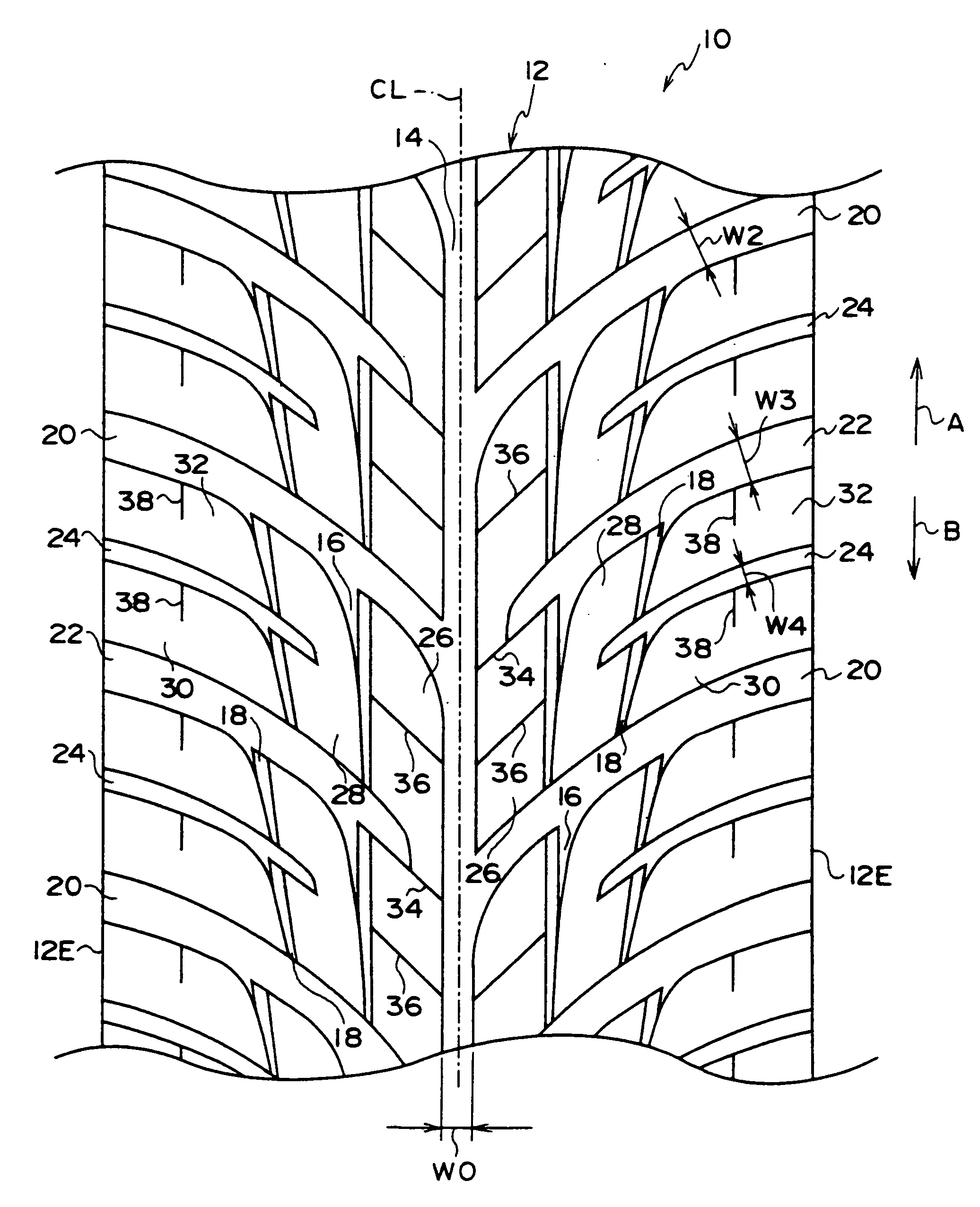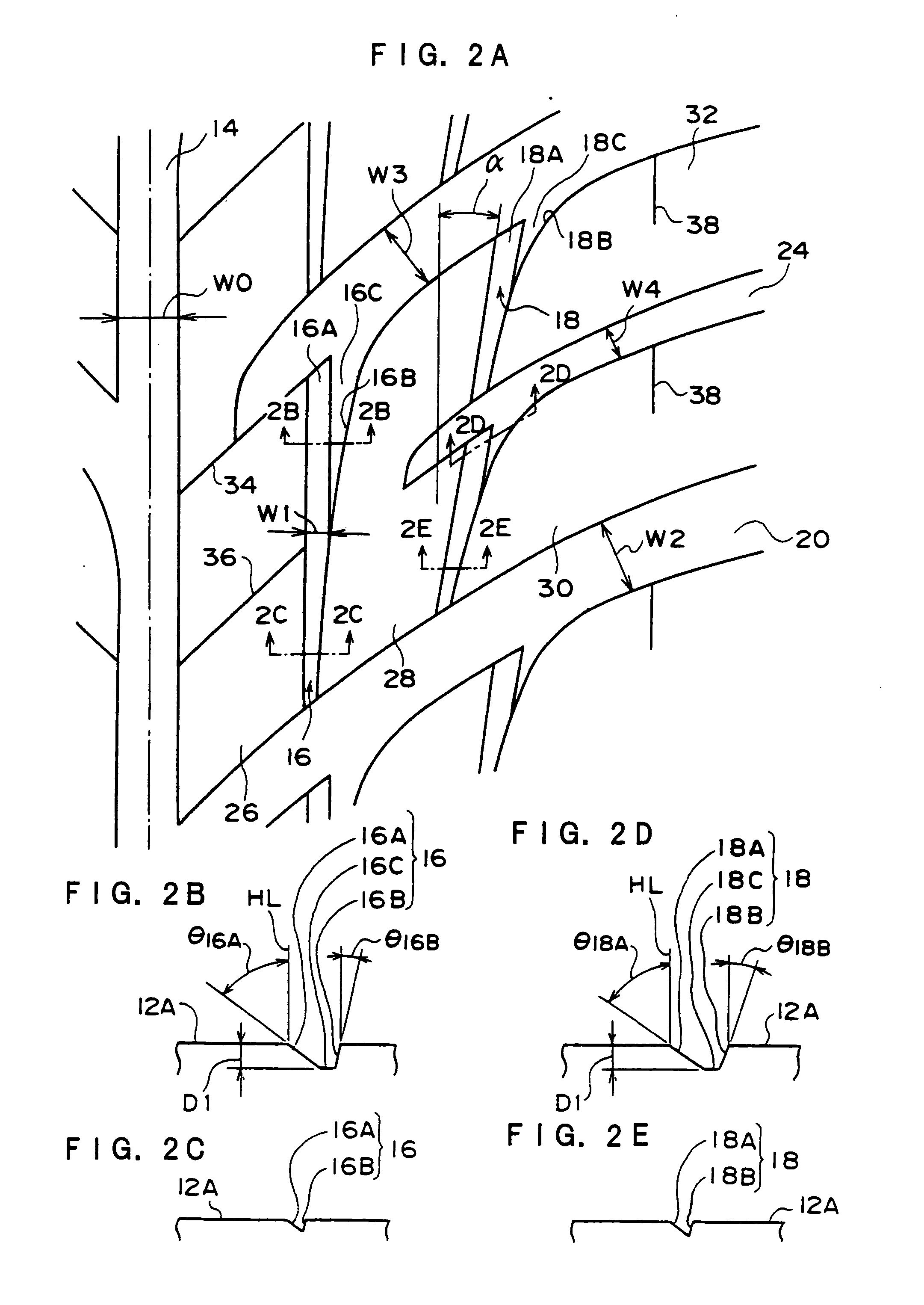Pneumatic Tire
a pneumatic tire and tire body technology, applied in the field of pneumatic tires, can solve the problems of low roadholding ability on dry road surfaces, drainage properties and roadholding ability to be decreased on wet road surfaces, and achieve the effect of high wet drainage performance and excellent
- Summary
- Abstract
- Description
- Claims
- Application Information
AI Technical Summary
Benefits of technology
Problems solved by technology
Method used
Image
Examples
first embodiment
[0123] A first embodiment of a pneumatic tire of the invention will be described in detail with reference to the drawings.
[0124] As shown in FIG. 1, a circumferential wide major groove 14 is formed on a tire equatorial plane CL in a tread 12 of a pneumatic tire 10 of the first embodiment. The circumferential wide major groove 14 is linearly extended in a tire circumferential direction (directions of arrows A and B, the direction of arrow B is a tire rotating direction). First narrow circumferential minor grooves 16 extended in the tire circumferential direction are formed on the outside in a tire axis direction with respect to the circumferential wide major groove 14. Second narrow circumferential minor grooves 18 extended in the tire circumferential direction are further formed on the outside in the tire axis direction with respect to the first narrow circumferential minor grooves 16.
[0125] As shown in FIG. 2A, a groove wall 16A on the side of the tire equatorial plane CL of the ...
second embodiment
[0178] A second embodiment of a pneumatic tire of the invention will be described in detail with reference to the drawings.
[0179] As shown in FIG. 3, a circumferential wide major groove 114 is formed on the tire equatorial plane CL in a tread 112 of a pneumatic tire 110 of the second embodiment. The circumferential wide major groove 114 is linearly extended in the tire circumferential direction. First narrow circumferential minor grooves 116 extended in the tire circumferential direction are formed on the outside of the circumferential wide major groove 114 in a tire axis direction. Second narrow circumferential minor grooves 118 extended in the tire circumferential direction are further formed on the outside of the first narrow circumferential minor grooves 116 in the tire axis direction.
[0180] As shown in FIG. 4A, a groove wall 116A of the first narrow circumferential minor groove 116 that is provided at the tire equatorial plane CL side is linearly extended in the tire circumfe...
third embodiment
[0237] A third embodiment of a pneumatic tire of the invention will be described in detail with reference to the drawings.
[0238] As shown in FIG. 7, a pneumatic tire 210 according to the third embodiment includes a carcass 212. The carcass 212 includes cords which are substantially extended in the radial direction, and both end portions are folded by bead cores 211 respectively. The carcass 212 is formed by a single layer or multilayer.
[0239] A belt layer 214 in which plural belt plies are laminated is embedded on the outside in a tire radial direction of a crown portion 12C of the carcass 212. A tread portion 218 in which the grooves are arranged is formed on the outside in the tire radial direction of the belt layer 214.
[0240] As shown in FIG. 8A, in a wheel tread portion 219 of the tread portion 218, a first outer major groove 222A extended in the tire circumferential direction is formed on one surface side with respect to the tire equatorial plane CL, and a second outer major...
PUM
 Login to View More
Login to View More Abstract
Description
Claims
Application Information
 Login to View More
Login to View More - R&D
- Intellectual Property
- Life Sciences
- Materials
- Tech Scout
- Unparalleled Data Quality
- Higher Quality Content
- 60% Fewer Hallucinations
Browse by: Latest US Patents, China's latest patents, Technical Efficacy Thesaurus, Application Domain, Technology Topic, Popular Technical Reports.
© 2025 PatSnap. All rights reserved.Legal|Privacy policy|Modern Slavery Act Transparency Statement|Sitemap|About US| Contact US: help@patsnap.com



